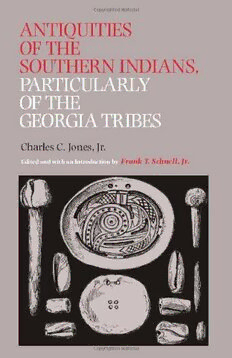
Antiquities of the Southern Indians, Particularly of the Georgia Tribes PDF
Preview Antiquities of the Southern Indians, Particularly of the Georgia Tribes
Antiquities ofthe Southern Indians, Particularly ofthe Georgia Tribes Classics in SoutheasternArchaeology StephenWilliams, Series Editor Publicationofthisworkhas been supportedin partbythe DanJosselyn Memorial Fund andthe SeminoleTribe ofFlorida, Anthropologyand Genealogy. ANTIQUITIES of the SOUTHERN INDIANS, PARTICULARLY of the GEORGIA TRIBES Charles C. Jones, Jr. Edited and with an Introductionby FrankT. Schnell, Jr. THE UNIVERSITY OF ALABAMA PRESS Tuscaloosa Copyright© 1999 The UniversityofAlabamaPress Tuscaloosa, Alabama 35487-0380 Allrights reserved Manufacturedinthe UnitedStatesofAmerica 12 34 56 789 • 07 06 05 04 03 02 01 00 99 Originallypublished 1873byD.Appletonand Company, NewYork CoverdesignbyGaryGore 00 Thepaperonwhichthisbookisprintedmeets the minimum requirementsofAmerican NationalStandardfor InformationSci ence-PermanenceofPaperfor PrintedLibraryMaterials, ANSI Z39.48-1984. LibraryofCongress Cataloging-in-PublicationData Jones, Charles Colcock, 1831-1893. Antiquities ofthe southernIndians, particularlyofthe Georgiatribes/Charles C. Jones, Jr. ;editedandwithan introductionbyFrankT. Schnell, Jr. p. cm.- (Classicsin southeasternarchaeology) Originallypublished: NewYork: D.Appleton and Co., 1873. Includesbibliographicalreferences. ISBN0-8173-1004-5 (pbk. :alk. paper) 1.IndiansofNorthAmerica-Georgia-Antiquities. 2. Indi ans ofNorthAmerica-SouthernStates-Antiquities. 3. Georgia-Antiquities. 4. SouthernStates-Antiquities. I. Schnell, FrankT., Jr. II. Title. III. Series. E78.G3J6 1999 975'.01-dc21 99-6213 ISBN978-0-8173-1004-2 (pbk. :alk. paper) ISBN978-0-8173-8407-4 (electronic) CONTENTS IntroductionbyFrankT. Schnell,Jr. VII Other Key Publications inthe 100Years MerAntiquities xxix Antiquities ofthe SouthernIndians, Particularly ofthe GeorgiaTribes xxxiii Indextothe Introduction 526 General Index 528 CharlesC.Jones,Jr., c. 1880 INTRODUCTION FrankT. Schnell, Jr. In the absence ofletters and ofrecorded memo ries most easily does one wave of human life sweepoveranother, obliteratingallformerrecol lections save such as are lodged in the womb of mounds, or preserved in the generous bosom of mother earth. -C. C. Jones, Jr. In 1906, a young boy visited the Stalling's Is land site on the Savannah Riverjust north ofAu gusta, Georgia. He had been inspired to visit the site after reading what he called an "eloquent eu logy ofthe mound" in Antiquities ofthe Southern Indians, Particularly of the Georgia Tribes, by Charles Colcock Jones, Jr. (Claflin 1931:3). The Bostonian Claflin family frequently visited their "winter" home near Stalling's Island and not far from Jones'sAugustahome. Overthe next twenty three years, he would continue periodic digging there until late 1928, when Mr. and Mrs. C. B. viii INTRODUCTION Cosgrove ofthe PeabodyMuseum ofHarvard Uni versity arrived to conduct slightly more than two months' intensive excavations, funded by Claflin (Stephen Williams, personal communication, De cember 11,1998). In 1931, the now grown William H. Claflin, Jr., would publish the landmark report The Stalling's Island Mound, Columbia County, Georgia, in the Papers ofthe Peabody Museum of AmericanArchaeology, Harvard University, based upon the Cosgroves', and his own work there. Claflin's publication is, in my opinion, the first "modern" archaeological report produced in Geor gia and perhaps the Southeast. By that, I mean that itwas the first to clearly demonstrate domes ticstratigraphicsequence, anachievementthathad eluded his predecessors and many ofhis contem poraries. Some ten years later, Charles Fairbanks reexaminedthesignificanceofStalling'sIslandand further clarified the stratigraphic sequence there (Fairbanks 1942). Awareness ofthe importance of thesitecontinuestogrow. Itisnow a NationalHis toricLandmarkheldbytheArchaeologicalConser vancy, preservedforits continuingpotentialto add new knowledge concerning not only the archaeol ogy ofGeorgia and the Southeast, but as the type sitefor the oldestceramicseriesinNorthAmerica. Charles Colcock Jones, Jr., was born in Savan nah on October 28, 1831 (Myers 1972:1568). His Jones ancestors had immigrated from England to Charleston, SouthCarolina, beforethefounding of the colony ofGeorgia. His great-grandfather had diedinthe defense ofSavannahduringtheAmeri can Revolution. His father, C. C. Jones, Sr., was a INTRODUCTION IX Presbyterian minister until just after his son's birth, when he moved his family to rural Georgia where, according to one biography, he devoted his energiesto"theevangelizationoftheNegro"(Myers 1972:1567). Jones, Jr., spent his youth at the fam ily plantations of"Montevideo" and "Maybank" in Liberty County, Georgia, near Savannah. In 1848 he attended South Carolina College at Columbia, spendinghisfreshman andsophomoreyearsthere. HemovedtoPrincetoninhisjunioryearandgradu atedwithdistinctionin 1852. HereadlawinPhila delphia for a year, then entered Dane Law School atHarvardUniversityandgraduatedwitha LL.B. in 1855.After graduation, Jones returned to Geor gia and was admitted to the bar in Savannah. In 1858, Jones married Ruth Berrien White head, and in the next year he was selected as an aldermanforthe cityofSavannah;inthefollowing yearhewaselectedmayor. Hewasservingasmayor when the Civil War began. Declining re-election, hevolunteeredforthe Chatham(County)Artillery, remainingon leave until a newmayorwas elected. By the fall of1862, he was chiefofartillery for the military district of Georgia, which was subse quently enlarged to include the third military dis trict of South Carolina. Preferring artillery, he declined a commission of brigadier-general of in fantry.Afterthedeathofhisfirstwifein1861,Jones was married a second time to Eva Berrien Eve of Augusta in 1863. Late in 1865 after the war had ended,hemovedwithhisfamilytoNewYork,where he practicedlaw andwhere he wroteAntiquitiesof theSouthernIndians. ReturningtoGeorgiain1877,
